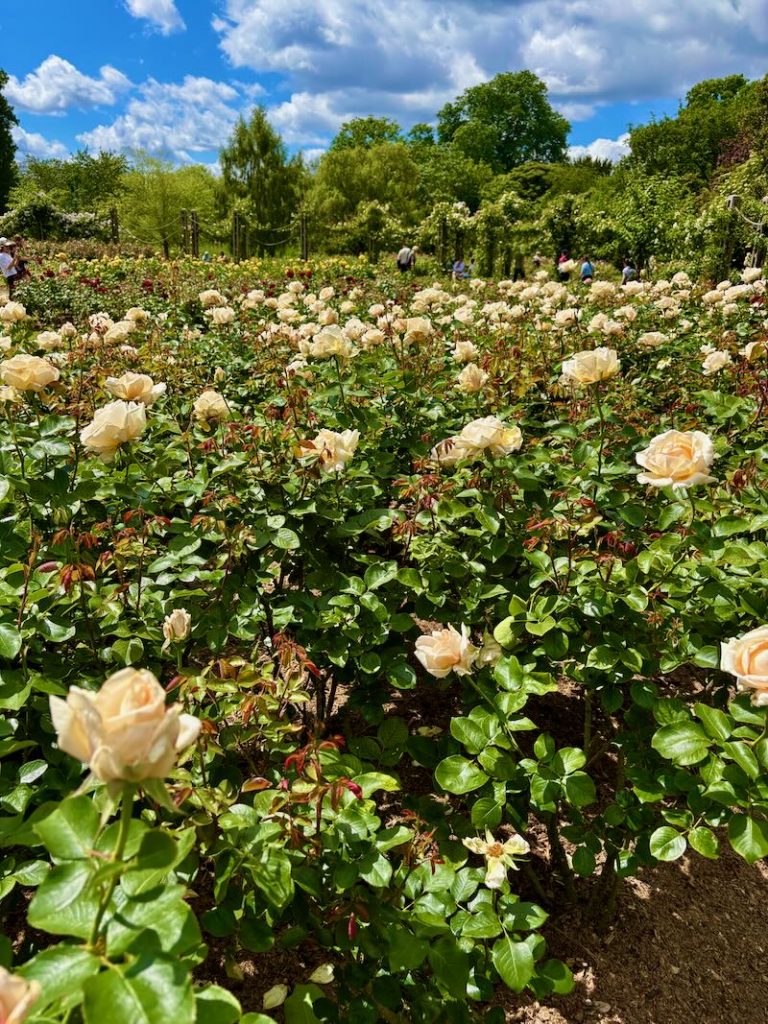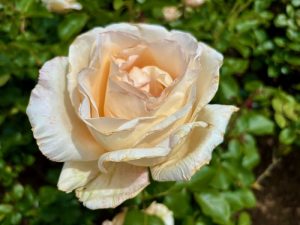Champagne Celebration Rose: Elegant Blooms with Lasting Beauty
Rosa ‘Champagne Celebration‘ brings soft, creamy blooms and steady performance to gardens large and small. You may see it marketed as Rose Champagne Celebration or Rosa Happy Celebration, and you might also encounter the breeder code Rosa ‘Frylimbo’. This compact Hybrid Tea comes from Gareth Fryer in the United Kingdom and belongs to the Rosaceae family. Plant it for high-centered, elegant flowers that open from pink-tinged buds and repeat in generous flushes from late spring into autumn. Keep the shrub well fed, watered, and pruned, and it will reward you with weeks of champagne-tinted color.
Rosa ‘Champagne Celebration’ delivers classic Hybrid Tea form with modern ease. Buds spiral open into large, double flowers with about 17–25 petals. Colors shift through cream, champagne, and soft apricot, then fade toward ivory in strong sun. The scent reads as moderate and fresh. Blooms appear mostly singly on short stems, yet small clusters form as well, so you enjoy both specimen-style blooms and mini bouquets on one plant. The display suits paths, patios, cutting gardens, and refined borders.
Flowering season and bloom character
Expect repeat bloom from late spring to autumn. In temperate climates, you see the first strong flush in early summer, a second in late summer, and more flowers into fall if you keep deadheading. Each flower spans about 8–12 cm (3–5 in). Cooler weather holds color longer; heat speeds the fade to cream. Cut a few stems for the house and the shrub keeps producing.
Growth habit of Rosa ‘Champagne Celebration‘
Rosa ‘Champagne Celebration’ grows with an upright, bushy habit that stays compact. In the ground, plan for 70–80 cm tall and 45–60 cm wide (28–32 in by 18–24 in). New canes break strongly from the base, yet the plant stays tidy with light shaping. Glossy, rich green foliage frames the blooms and keeps the shrub handsome between flushes. In containers, height usually tops out nearer 60–70 cm (24–28 in), which fits balconies and small patios.
Give this rose full sun for peak bloom, at least 6 hours daily. Rosa ‘Champagne Celebration’ handles summer heat if you water deeply and mulch well. Afternoon shade helps in regions that regularly exceed 32°C (90°F). The roots prefer evenly moist, well-drained soil. Prolonged saturation invites trouble, so improve drainage if you garden on heavy clay. With good airflow, proper spacing, and clean cultural habits, the plant resists common rose issues better than many older hybrids.
How to grow Rosa ‘Champagne Celebration‘:
Light
Plant Rosa ‘Champagne Celebration’ where sun lingers. Aim for 6–8 hours of direct light. Morning sun dries leaves fast after dew or rain and reduces disease pressure. In very hot climates, offer light afternoon shade to protect flower color and reduce stress.
Soil
Prepare fertile, moisture-retentive, free-draining soil. Work 5–8 cm (2–3 in) of compost into the top 30–35 cm (12–14 in). Target a slightly acidic to neutral pH around 6.0–6.8. If your site drains slowly, raise the bed by 10–15 cm (4–6 in) or plant Rosa ‘Champagne Celebration’ on a shallow mound so water moves away from the crown.
Watering
Water deeply, not often. In average summer conditions, give 10–15 liters (2.5–4 gal) per plant once or twice each week. Adjust to heat and rainfall. Soak the root zone until moisture penetrates 20–25 cm (8–10 in). Keep foliage dry to limit disease. In containers, check daily during heat waves and water when the top 2–3 cm (¾–1 in) of mix feels dry.
Fertilizing
Feed to fuel repeat bloom. Apply a balanced, rose-specific granular fertilizer in early spring as buds swell, then feed again after the first flush. In mid-summer, give a lighter feed if growth slows. Follow label rates. In containers, supplement with a half-strength liquid feed every 2–3 weeks from late spring through midsummer. Stop fertilizing 6–8 weeks before your usual first frost to help the plant harden off.
Mulching
Mulch after planting and refresh each spring. Spread 5–8 cm (2–3 in) of composted bark, leaf mold, or well-rotted manure over the root zone. Keep mulch 5 cm (2 in) away from the canes. Mulch stabilizes soil temperature, conserves moisture, and reduces splash-borne disease.
Planting and spacing
Space shrubs 45–60 cm (18–24 in) apart for airflow. Dig a hole wide enough to spread the roots. Set the plant at the same depth as the nursery pot. In colder regions, you can set the graft (bud union) 2–5 cm (¾–2 in) below soil level for added winter insurance. Backfill with amended soil, firm gently, and water thoroughly to settle the root ball. Add mulch once the soil drains.
Pruning and deadheading for more flowers
Prune in late winter or very early spring. Start by removing dead, damaged, or crossing canes. For a tidy Hybrid Tea, keep 3–5 strong canes and shorten each to 20–30 cm (8–12 in), cutting to outward-facing buds. In mild climates, you can prune a bit higher, around 30–40 cm (12–16 in), to preserve foliage. Through the season, deadhead spent blooms. Cut back to the first strong five-leaflet leaf to reset the stem. After the early summer flush, trim the shrub lightly by 10–15 cm (4–6 in) and feed to trigger the next wave.
Planting Rosa ‘Champagne Celebration‘ in containers
Choose a pot 40–50 cm (16–20 in) wide and 35–40 cm (14–16 in) deep, with large drainage holes. Use a high-quality peat-free potting mix blended with 20–30% compost and about 10% perlite or grit for drainage. Set the crown at the same depth as in the nursery pot. Water until excess runs from the base. Position the container in full sun with good airflow. Rotate the pot a quarter turn every two weeks for even growth. Expect faster drying than in the ground and adjust watering accordingly.
Winter care and cold protection
In cold-winter climates, mound 15–20 cm (6–8 in) of compost or shredded leaves over the crown after the first hard frost. Pull the mound away in early spring as buds swell. In windy, exposed sites, create a breathable windbreak or move containers to a protected wall. In mild regions, a spring cleanup, fresh mulch, and the regular pruning routine usually suffice.
Propagation of Rosa ‘Champagne Celebration‘
Take 12–15 cm (5–6 in) semi-ripe cuttings in late summer or hardwood cuttings in late winter. Remove lower leaves. Dip the cut end in rooting hormone. Insert each cutting into a free-draining medium of two parts perlite to one part compost or peat-free seed mix. Keep humidity high and light bright but indirect. Rooting often takes 6–10 weeks. Because seed does not grow true to cultivar, avoid sowing. Commercial growers bud onto vigorous rootstocks, but home gardeners can keep plants on their own roots if cuttings root well.
Pests and diseases
Aphids: Aphids gather on tender tips in spring. Knock them off with a strong water jet. If they rebound, use insecticidal soap and repeat at intervals. Attract beneficial insects by growing dill, fennel, or yarrow nearby.
Spider mites: Hot, dry spells favor mites. You see stippled leaves and fine webbing. Increase soil-level moisture with mulch and deep watering. If needed, apply horticultural oil in the cool of day and repeat as directed.
Thrips: Thrips can mark pale petals. Remove badly damaged blooms and keep the bed clean. In greenhouses, use blue or yellow sticky cards to monitor. Outdoors, steady moisture and airflow reduce pressure.
Japanese beetles and leaf-chewing caterpillars: Hand-pick beetles into soapy water early in the morning. Inspect leaves for caterpillars and remove them. Use Bacillus thuringiensis (Bt) on young larvae if populations spike.
Black spot: This fungal disease spots leaves and causes early drop. Prevent it with spacing, mulch, and careful watering at soil level. Remove fallen leaves promptly. If it appears, prune out infected foliage and consider a preventive spray program with sulfur or other labeled fungicides, alternating modes of action.
Powdery mildew: You may see a white coating in cool nights and warm days. Improve airflow, avoid drought stress, and prune lightly to open the center. Remove infected tips and consider a labeled fungicide if needed.
Rose rust: Orange pustules on leaf undersides signal rust. Catch it early, remove affected leaves, and boost airflow.
Feeding schedule at a glance for Rosa ‘Champagne Celebration‘
Early spring brings the first feed. Use a balanced granular product and water it in well. After the first flush, feed again to drive the next set of buds. In mid-summer, give a lighter feed if growth slows. For containers, add a half-strength liquid feed every 2–3 weeks from late spring to midsummer. Taper late in the season so canes mature before frost.
Smart watering made simple
Check moisture 10 cm (4 in) down. If it feels dry, water until the top 20–25 cm (8–10 in) of soil is moist. In heat, you may repeat every 3–4 days. In cooler weeks, every 5–7 days often suffices. For containers, water until it flows from the base, then empty saucers so roots never sit in standing water.
Landscape uses and design ideas for Rosa ‘Champagne Celebration’
Use Rosa ‘Champagne Celebration’ as a refined front-of-border accent. Thread three shrubs through a 2 m (6½ ft) bed with catmint and salvias for a long season of color that also pleases pollinators. Line a sunny path with pairs planted 60 cm (24 in) apart to create a low ribbon of cream and green.
Set a single plant in a 45 cm (18 in) clay pot by a seating area and enjoy the moderate fragrance at close range. For a pale scheme, echo the blooms with white gaura, silver artemisia, and soft pink penstemons. In cutting gardens, harvest stems when outer petals start to unfurl. Recut under water and condition for a few hours for a vase life of 4–6 days.
Troubleshooting common issues
Few or no flowers usually point to shade, hunger, or drought. Move Rosa ‘Champagne Celebration’ to full sun, step up feeding, and water deeply. Pale growth suggests low nutrition or high pH; add compost and a balanced feed, then check soil pH. Petal scorch in heat eases with afternoon shade and better hydration. Wind tears petals on exposed sites; provide an airy screen and prune lightly after storms to refresh the display.
Quick facts for planners
Type and habit: compact Hybrid Tea with an upright, bushy silhouette.
Height and spread: 70–80 cm tall by 45–60 cm wide (28–32 in by 18–24 in).
Bloom: high-centered, double flowers, 8–12 cm (3–5 in) across, moderate fragrance, repeat flushes late spring to autumn.
Best light: full sun; light afternoon shade in extreme heat.
Soil: fertile, well-drained loam enriched with compost, pH 6.0–6.8.
Water: deep, regular soaks; about 10–15 liters (2.5–4 gal) weekly in dry spells.
Hardiness and climate: suitable for many temperate regions with winter protection in colder zones; containers allow easy shelter.
Names you may see: Rosa ‘Champagne Celebration’, Rose Champagne Celebration, Rosa Happy Celebration, Rosa ‘Frylimbo’ (breeder code).
Why choose Rosa ‘Champagne Celebration‘ for modern gardens
You want a classic bloom that behaves well in a compact space. You prefer a palette that blends with many partners. And you value repeat flowering without fussy rituals. Rosa ‘Champagne Celebration’ meets those goals. It fits front borders, pots, and paths. It offers elegant flowers for the vase and enough vigor to refresh itself all summer with simple deadheading and sensible care.
Set this rose in sun. Enrich the soil and improve drainage before you plant. Space 45–60 cm (18–24 in) apart for airflow. Water deeply after planting and mulch 5–8 cm (2–3 in). Feed in spring, prune in late winter, and deadhead through summer. Keep leaves dry, remove fallen foliage, and you will keep disease at bay. With these steps, Rosa ‘Champagne Celebration’ will deliver champagne-toned flowers from the first warm weeks of summer until frost.



